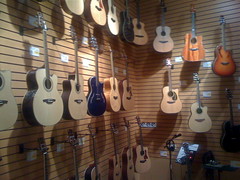 Image via Wikipedia
Image via Wikipedia Image by Sweetwater Sound via FlickrAcoustic Guitar: Buying Guide
Image by Sweetwater Sound via FlickrAcoustic Guitar: Buying GuideWhether you're playing in front of a coffee house full of loyal fans, or your fireplace in your home, an Acoustic Guitar from Sweetwater is the perfect instrument! This Sweetwater Buying Guide includes information that can help you choose an Acoustic Guitar for your needs.
Acoustic Guitar
Body Style:
Acoustic guitars come in a variety of sizes and shapes, from small travel size, to jumbo, to dreadnought. The body style in an acoustic guitar determines sound projection and tonal emphasis. Things to consider are tonal quality vs. playing comfort. Some acoustic guitar bodies come in a single cutaway design like the shape of the Gibson Les Paul. This gives access to the higher frets.
Electronics:
Some acoustic guitars come with pickups and preamps built in for playing larger venues where your acoustic sound needs to fill the room. Some instruments have preamps mounted in a hole cut in the side of the instrument, while others mount inside the soundhole. There are systems that combine preamp, microphone, piezo pickups , EQ, and tuners.
Neck:
The concept for necks on acoustic guitars is the same as it is for electrics; the size of your hand is key. Generally the thickness and width of the neck is based on the size of the body of the instrument as well as how many frets the neck has. Usually, acoustic necks are listed as 12-fret or 14-fret. This refers to the number of frets clear of the body, not how many overall.
Intonation:
Intonation determines whether or not the notes play in tune as you move up the neck. If the distance between the frets (usually above the 12th fret) is off, the guitar will be incapable of playing in tune and therefore useless as a recording or performance instrument.
Tonewood:
The choice of wood determines the sound of an acoustic guitar. Different types of wood produce different tones, but most guitar makers believe that the top is the most important for determining tonal quality. Spruce is the standard material for tops with Sitka spruce being the most common. The cost of an acoustic guitar increases dramatically based on the rarity of the tonewoods, such as rosewood, but due to decreasing supplies of certain tonewoods, guitar makers are successfully finding alternative materials to make great sounding instruments.
Tuning Machines:
The type of tuning machine your guitar has is very important. This is what allows you to fine tune and hold pitch. Enclosed machine heads resist rust and airborne corrosives, and therefore don't require as much maintenance or replacement as open tuning machines.
Bridge and Fingerboard:
The materials used for bridge and fingerboard do have an effect on sound, but this is minimal compared to the body of the guitar. Put simply, the effects of bridge and fingerboard materials cannot make or break a guitar's sound.
Finish:
Different types of finish can affect the way the wood vibrates, but there is nothing you can do about this. These decisions are make by the guitar maker and they usually choose wisely.
***
Read more at Sweetwater:
http://www.sweetwater.com/shop/guitars/acoustic/buying-guide.php












0 comments:
Post a Comment